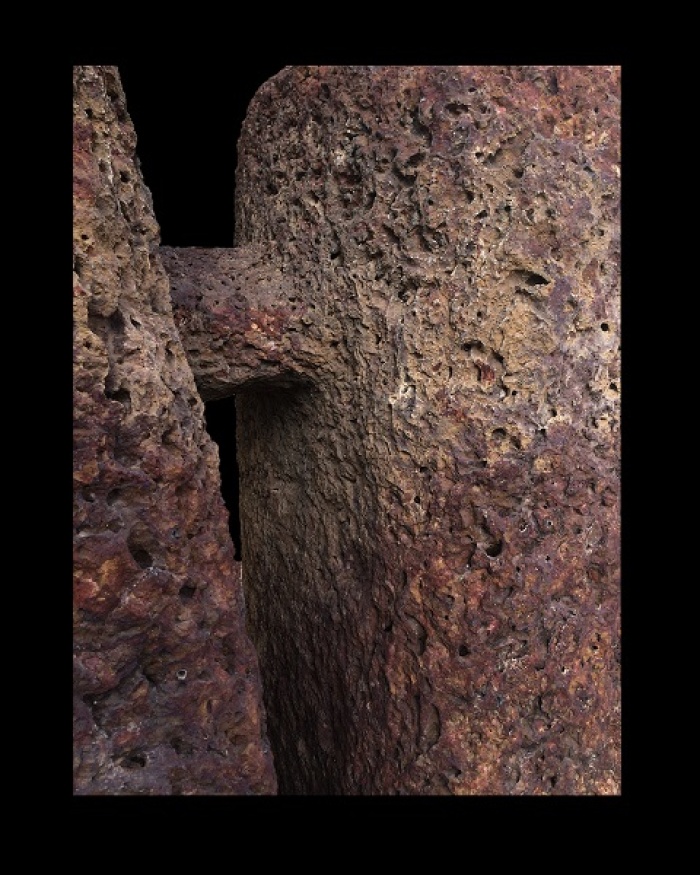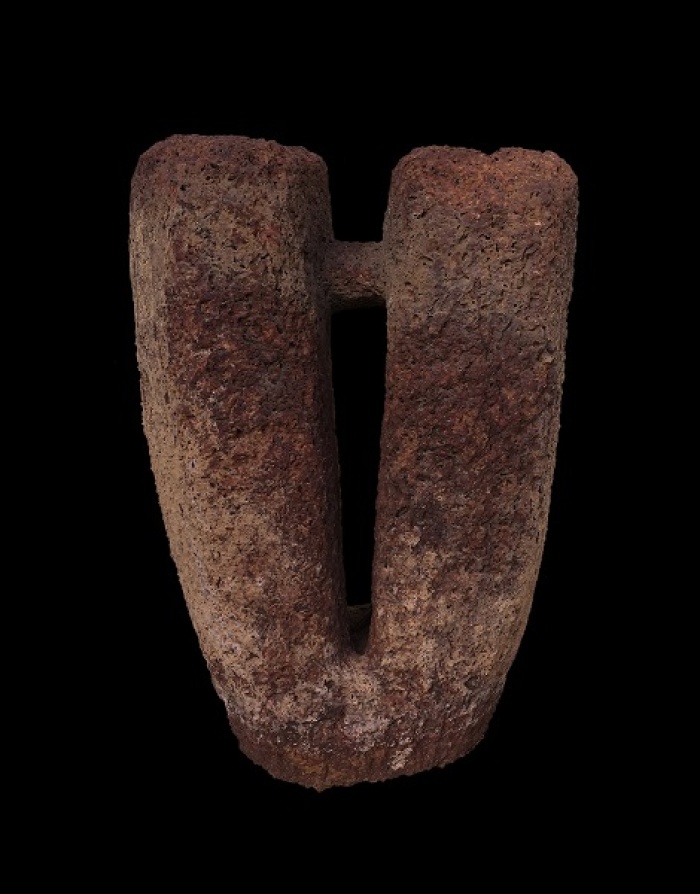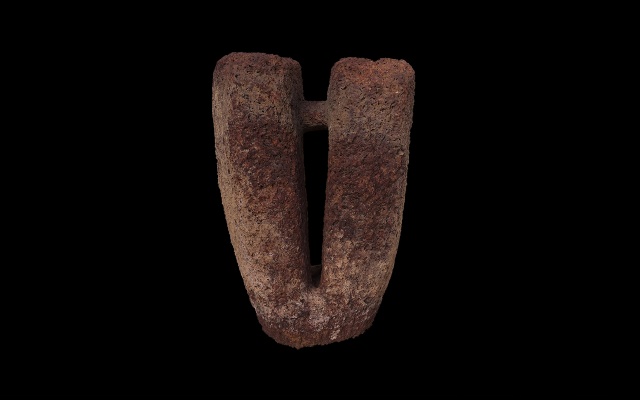I.
The Stone Circles
In the territory of Senegal there are around one thousand megalithic structures including stone circles in Wanar and Sine Ngayen, listed as UNESCO World Heritage Sites, in 2006. The megalithic circles in Senegal are composed of standing stones, also called megaliths, there are between ten and twenty-four in number with their height up to two meters above ground. All the stones in a particular circle are always of the same size however; some of the sites have double rings one enclosed within the other. There is a considerable variety in the shape of the megaliths – some are square in section, some taper upwards, and others are round with a flat top. In rare cases there are also so-called frontal stones with two upright parallel branches held up by a tenon. They occur individually outside circles and always on their eastern side. The megaliths are cut out of laterite, a type of ferruginous sandstone that occurs in large outcrops in this region. The process of hardening upon exposure to the air is a distinctive feature of this specific rock but prior to this, it is relatively easy to quarry. In cases of some of the megalithic monuments the quarry sites have been identified a kilometer or so away from them and it is said that several men using iron tools could have cut out one of the larger megaliths within a few days. The only few traces left of those who constructed the monuments are the stone circles, the grave-sites, and perishable fragments of funerary houses. In their form and position the megaliths are portals and points of transition. They embody the intersection of the two worlds: the hidden and the visible one. Partly buried in the ground, with the bodies concealed underneath them, the megaliths stay connected to death and ancestors, and forces of the universe. Their upper parts reaching upward become sacral altars that mark gravesites and point towards the sky. What we know today is that most of the megalithic sites have long served a ritualistic use, and that their formation is almost certainly related to the burial pits below them. The inverted A-shaped megaliths (∀) face an eastward direction and many of them are engraved with votive carvings or sun discs indicating a close relationship to sun worshipping practices and rituals. Excavation and reconstruction work detailing the placement and the position of the underlying bodies, form an image of celestial-like bodies suspended in an enigmatic planetary system that is demarcated by the two stone orbs.
Some people from the villages close to Wanar swear that at nights they would often see a beam of light shooting from the inside of the stone circles; others claim that with every year the megaliths swell and grow taller.
II.
The Gaze
To be oneself and the O/other. Is it possible that in a split second your self shatters into many disparate perspectives of who you are?
You are included
at the same time
you do not belong.
The immediacy of the rupture was formidable. On that day, travelling towards the city center in Poznań with my classmates on tram number 12, one of my friends exclaim in excitement calling me: “Look Maja! A Negro [Murzyn]!” while pointing out the window. Immediately, all my peers run in the indicated direction gluing their grinning faces to the windowpane, jostling with one another to see the Other. I stand frozen. I refuse to look. I feel a sting running through my chest and my guts. The O/other in me has shoved my body from the inside and it jerked. Or maybe, the last stringy thread of my viscous self has snapped and divided itself in two– me, and the O/other. I become my Senegalese father’s daughter. The centrifugal force thrusts me out of the tram next to the Black man standing outside the window.
There are two of you. Mixed, they say. There are always two of you; one for you, and one for the others. Half and half, they say. The one who is whispered about on a train and on a bus. The one who is looked at. To be looked at. Talked about. Pointed at. Is this still you? You develop a different walk. The outside walk. The walk for others. You walk outside. You are hidden, yet always so present wherever you go. Visible. There are two of you inhabiting this one Brown Body. You have never fully belonged to your mother, but she insisted to recognize you as her own. She knew that the mark of the kinship, between you and her, has been deeply concealed under your skin. Am I really your daughter? I would sometimes ask, caressing her fragile head resting on a pillow, after she has fallen asleep.
III.
Black blood
– You see, said my father, people in Poland would not know about Africa. For example, they would think we live in trees and ask me: “What is the number of the tree that you live in?” Once I met a girl at a party and she asked me about the number of my tree and I said to her: “I think it is number one hundred because our village is pretty large.”
– Kids would come to me and my African friends, he continued, and ask us what time it was, since their parents had told them we were able to judge the time by the position of the sun. Whenever I saw kids running up to me, I would check my watch quickly and then, when asked, I looked up in the sky at the sun and would tell them the exact time. The kids would run away shouting: “It is true! Negros can read time from the sun!”
– I remember when a woman once asked me: “What color is your blood?” and I told her that it was black. She went and told everyone in the office that Black people have black blood. Then, another woman came shortly after in order to confirm the rumor about the color of my blood. I told her: “Are you crazy?! Blood is always red!” The first woman was very upset with me for lying to her.
Blood is always red
Sometimes red and white, and sometimes black and white
Black and white
– It happened often, he remarked, that some people would come to me and rub their fingers against my skin. They were trying to check to see if the color would come off and stain their hands.
– Another day, he continued, we would go to the shop in a small town where I was an intern during my studies. There were a few of us African students, Senegalese and Gambians, when suddenly a woman who saw us walking in her direction cried out: “Angels! I see black angels coming towards me!” And she fainted – in front of us.
It was explained to him later that angels in the town’s church have black faces and that is why the woman believed she had seen real angels approaching her. My father and I, we both shared the same experience of Otherness and Otherworldliness.

(c) Maja ∀. Ngom
IV.
Roots [from the dream]
Down in the tidal mouth of the Saloum River, the waters of the Atlantic Ocean are injected into the mainland of Senegal. Rushed into the arteries of thin branches and inlets, they diverge and undulate rhythmically. I am in my father’s native village perched on the brackish waters of Djilor River flowing from the Saloum delta. Standing in the backwaters only a few steps away from my grandmother’s house, I look at the warming horizon marked by the irregular line of mangroves. Suddenly, the water around me starts to swirl in countless whirlpools. I lean forward and notice hundreds of eels slithering frantically in the muddy ford of the river. A few of them jump out of the water and deftly slide up my body, sticking to my limbs. They move higher and higher until they reach my wide-open mouth and push themselves in my toothless gums.
V.
Polish Chocolate1
The sweet taste of my Otherness caught me by surprise. It was during my adolescence when I recognized the fragrant, bittersweet scent of cocoa permeating my life. I was a chocolate bar. I was a moist chocolate cake with sour cherries. I was a dark chocolate-coated marshmallow ice creamlike treat served to children after Sunday mass. I was a deep red; the juiciest of all of the strawberries – bursting into flames of sweetness. My pointy tits ornamented with raisins were sizzling on their tongues. The augury of my fate written in my father’s flavorsome lips and his tender kiss gifted to my mother has been fulfilled. And yet, regardless of all the sweetness, these words leave a bad taste in my mouth whenever articulated and thrown as an insult.
VI.
The ∀
In I.F.A.N archives at Cheikh Anta Diop University in Dakar, I come across a series of photographs documenting works carried out in 1967 in the Kaffrine region. Frame by frame the images present the excavation process of a megalithic frontal stone in Soto village: the earth is carefully removed revealing the base of the megalith, and with the help of warps and chains, the stone is hefted and then pulled out of its place like a milk tooth.
The megalith was sent to Paris with twenty other Senegalese artworks, in exchange for fifteen French tapestries based on modernist paintings, and handwoven in the traditional style of the town of Aubusson.
The same year the megalith has joined the collection of the Museum of the Arts of Africa and Oceania, the later Quai Branly Museum, where it has stayed until today.

(c) Maja ∀. Ngom
Archeological object: The Megalith
Pierre-lyre [lyre-like]
Collection number: 73.1967.2.1 D
Dimensions: 210cm x 160 cm x 80cm, weight 3,8 tones
Just like other megaliths from Senegal it is made of laterite rock and has a rusty-brown color darkening at the top of its parallel pillars. It’s porous but having been worked to a smooth texture resembles that of a pumice rock with a multitude of interstices piercing its flesh. It seems that tiny bubbles of air were caught in the depths of the earth where the rock had been forming. In the middle of the museum corridor the megalith marks the beginning of the African collection. In the simplicity of its shape and the nakedness of its colors the megalith stays silent and invisible within the museum.
VII.
Pangool
It is evening. We were sitting together with my father in the courtyard of his mother’s house, when he started to talk. His fluid narrative goes from harvesting and botany to spiritual subjects, in his eyes it is all interconnected in one form of an octahedron. His resonant voice is warm and soft.
“When water is very calm and there are no waves if I stay here, I can tell you that fish is over there.” He points the direction of the mangrove-lined part of the river. “And sometimes too, it’s very mystical. When you are sleeping, sometimes you can see that it is going to rain on a certain day, let’s say Monday. Some people can tell you this! Or, for example, some people can tell you that next day or next week this person will die. Because they know that a certain person has not much time left to live. You can tell it by the way the person walks; their feet are not touching the ground. Les pieds ne touchent pas la terre.” He repeated in French. “But not everyone knows it only some people will be able to see it. They can tell that. Now, there are some, I don’t know how to tell you,” he struggles to find the right words to explain, “like maybe ‘ancestry.’” There are times when I sleep, or even if I don’t sleep, I can hear it sometimes. I can hear voices telling me something. Then at that time I’m absent. I cannot talk to you but I can hear everything. It is as if I am lost. But when I have heard something then I know it will be true. You just simply know that it will be true. Let’s say, I hear some people and then some voice says – this person will die – I know, it is true.” He pauses. “But of course, I cannot say it. How can I tell somebody: your father is going to die, or your mother will die tomorrow? Nobody knows it. You cannot say it. Sometimes in a family you have a thing like this that protects the family. I don’t know what to call it in French but in Serer we call it Pangool. It comes from our ancestors. It is a force – an up-stack force. And when you have problems, they will alert you. Like spirits.”
BIO
Maja ∀. Ngom is a Polish-Senegalese visual artist, currently based in London. She studied Ethnolinguistics Philology and Cultural Studies at The Adam Mickiewicz University in Poznan; and received an MA in Photography at the Royal College of Art in London. Her multidisciplinary practice encompasses still and moving image, writing and sculpture.
In her works, Ngom investigates identity in the context of belonging and displacement, alluding to post-structural feminist literature and phenomenological thought. Informed by her personal experience of coming from an inter-generational and multi-ethnic family her works recount fragmented narratives of fictionalized autobiographies, fluid identities and otherworldly events.
* Cover photo: Maja ∀. Ngom
[1] The variations of word Murzyn are often used in Poland in culinary domain to name cakes e.g. Little Negro [Murzynek], Negro’s lips [Usta Murzyna], Negro’s kiss [Pocałunek Murzyna], Mulatto’s tits [Cycki Murzynki], to mention only few. Moreover, the popular variety of Senga Sengana strawberry sold in Polish markets is popularly referred to as Little Negro Girl (Murzynka).



